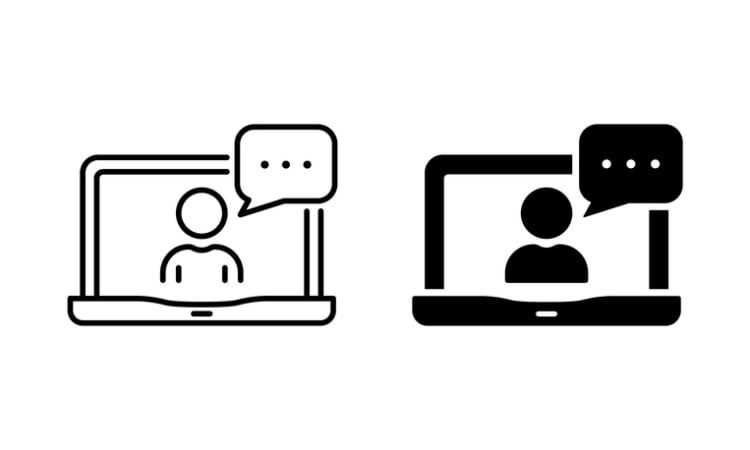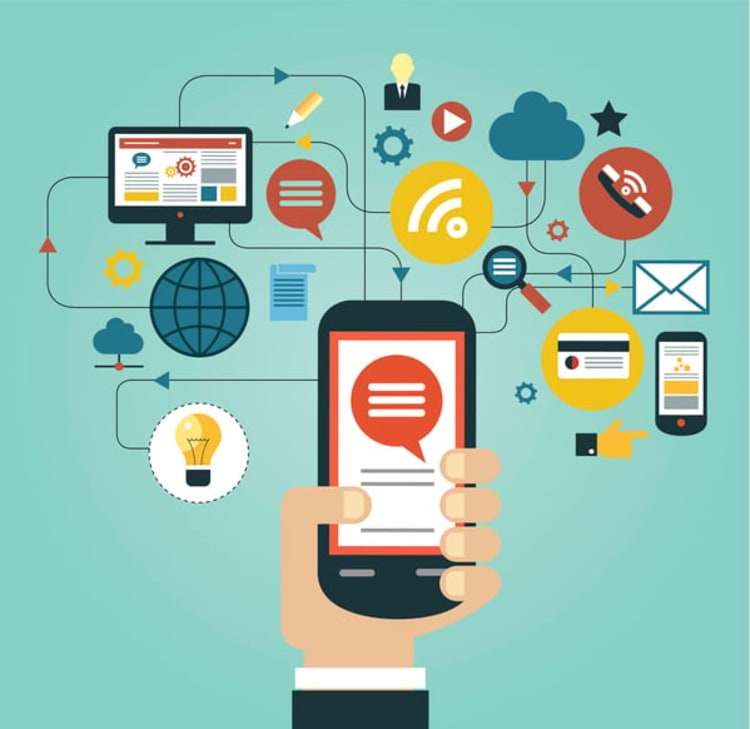In today’s fast-paced business landscape, communication is the backbone of success. The right communication channels can make all the difference in productivity, collaboration, and customer satisfaction. But with so many channels available, how do you choose the best ones for your business? This blog post will guide you through the process of understanding, selecting, and implementing various communication channels to optimize your business performance.
Key Takeaways
- Understand communication channels and their advantages/disadvantages for successful business communication.
- Utilize verbal, written, digital & non-verbal techniques to foster connection with the listener while maintaining a professional tone.
- Evaluate current channels and introduce new ones to promote team collaboration & customer engagement.
Understanding Communication Channels

Effective communication forms the lifeblood of business communications, facilitating the exchange of information, queries, and responses with all stakeholders, internal and external. There are three primary effective communication channels: verbal, written, and non-verbal. Each channel comes with a unique set of advantages and disadvantages, making the selection of the right effective communication channel vital to optimize both internal and external communications.
This not only improves productivity and collaboration but also enhances customer satisfaction and overall business success.
Types of Communication Channels
There are various types of communication channels, ranging from verbal and written to digital and non-verbal. Verbal communication channels include formal, informal, and unofficial communication. Within the realm of written communication channels, the formal communication channel encompasses emails, business plans, annual reports, written strategies, contracts, company-wide correspondence, safety guidelines, presentations, and more.
In today’s world, different communication channels play a significant role in how we interact with one another. Digital communication channels, on the other hand, include video conferencing tools, instant messaging apps, and project management software. Non-verbal communication channels involve body language, eye contact, and facial expressions.
Every channel has a unique purpose and suits different situations, hence businesses need to understand and utilize a diverse combination of these channels to achieve optimal communication.
Internal vs. External Communication
Internal and external communication channels serve different purposes in a business context. Internal communication channels focus on team collaboration, allowing employees to share information, updates, and documents with one another. Examples of internal communication channels include messaging apps, intranet platforms, and team meetings. Effective internal communication is paramount to assure alignment of everyone in the organization with the company’s goals and objectives.
On the other hand, external communication channels are focused on customer engagement, public relations, and marketing. These channels include:
- letters
- catalogues
- direct mail
- emails
- text messages
- telemarketing messages
- social media platforms
- press releases
- live chat
External communication channels enable businesses to interact with customers, prospects, partners, and other stakeholders, helping to build brand awareness, generate leads, and drive sales.
The selection of a well-balanced mix of internal and external communication channels is pivotal for any business’s growth.
Verbal Communication Strategies

Verbal communication plays a vital role in the workplace as it facilitates the exchange of:
- ideas
- information
- feedback among team members. However, the effectiveness of verbal communication can be significantly influenced by factors such as:
- tone
- inflection
- active listening
For clear and effective verbal communication, one must focus on these aspects and devise strategies for improvement.
Tone and Inflection
The tone and inflection of your voice can greatly impact the way your message is perceived by others. By using the appropriate tone and inflection, you can convey emotions, attitudes, and intentions more effectively, providing additional context to the words being spoken.
This not only helps to clarify your message but also fosters a connection with the listener. Being mindful of your tone and inflection can help you avoid misunderstandings and ensure successful verbal communication.
Active Listening
Active listening is a crucial skill in verbal communication, as it helps to foster understanding, create a connection, and improve the overall quality of communication. Active listening involves fully concentrating on the speaker, taking note of both verbal and non-verbal cues, and providing feedback to ensure that the message is accurately received and understood.
Practicing active listening techniques like paraphrasing, seeking clarification, and providing feedback, can lead to enhanced communication, reduced misunderstandings, and fortified team relationships.
Written Communication Techniques

Written communication is another essential aspect of effective business communication. It allows you to convey information, instructions, and updates in a clear and concise manner. Unlike verbal communication, written communication can be composed over an extended period and is usually asynchronous. This enables you to:
- Carefully craft your message
- Ensure that it is accurate
- Make sure it is well-structured
- Ensure that it is easy to understand
For maximizing the benefits of written communication, it is important to hone techniques for both formal and informal writing.
Formal Writing
Formal writing is used for creating contracts, reports, and other official documents. It is essential to follow a structured and organized approach to ensure clarity and professionalism. By adhering to specific formats and using precise language, you can guarantee the accuracy and validity of your documents.
Developing strong formal writing skills can not only improve the quality of your written communication but also enhance the credibility of your business.
Informal Writing
Informal writing, on the other hand, is used for casual communication and team collaboration. It is more relaxed and personal, allowing you to express your thoughts and ideas more freely. Examples of informal writing techniques include:
- using slang
- using contractions
- using emojis
- using casual language
By mastering informal writing, you can create a more comfortable and engaging environment for your team, encouraging open communication and fostering a sense of connection.
Digital Communication Platforms

Digital communication platforms have become increasingly popular in today’s modern business environment, offering efficient and accessible workplace communication. These platforms enable team members to collaborate, coordinate, and monitor progress in real-time, streamlining communication and enhancing productivity.
Utilizing digital communication platforms like video conferencing tools, instant messaging apps, and project management software enables businesses to maintain connectivity and agility, ensuring unified efforts towards common goals.
Video Conferencing Tools
Video conferencing tools are essential for remote team meetings and presentations, allowing for real-time collaboration and engagement. By replicating the experience of in-person meetings, video conferencing enhances communication among remote teams, reducing the need for travel and fostering stronger connections.
Popular video conferencing tools, such as Kumospace, offer features like screen sharing, making it easier to collaborate on projects and share information during meetings.
Instant Messaging Apps
Instant messaging apps provide a quick and direct means of communication between team members, enabling rapid responses and real-time collaboration. These apps, such as Kumospace, Slack and Discord, offer features like file sharing, project or team-based channels, and integration with other communication tools.
By utilizing instant messaging apps for business messages, companies can enhance their internal communication, leading to increased productivity and more efficient teamwork.
Project Management Software
Project management software is a platform for task tracking and management, allowing teams to collaborate, allocate resources, and schedule tasks efficiently. By providing features such as due dates, notes, and assigned subtasks, project management software streamlines task management, ensuring that everyone is aware of the project’s objectives and working towards them.
Utilizing project management software can lead to improved communication, more efficient task management, and better visibility into project timelines, milestones, and dependencies.
Enhancing Digital Engagement
In a world abundant with communication channels, understanding channel definition in communication becomes pivotal. Channels like Kumospace redefine channel communication by offering spatial, interactive virtual environments, setting themselves apart as distinct examples of communication channels. With Kumospace, users can engage in dynamic digital interactions that capture the essence of in-person conversations, making it an ideal addition to your communications channel arsenal. As businesses explore and evaluate their current strategies, introducing platforms like Kumospace ensures both team collaboration and customer engagement thrive in the digital age.
Non-Verbal Communication Cues

Non-verbal communication cues are essential aspects of professional interaction, conveying emotions, attitudes, and intentions without the use of words. These cues include facial expressions, body language, and eye contact, which can provide additional context and meaning to both verbal and written communication.
Mastering non-verbal communication cues can boost your overall communication skills and ensure accurate receipt and comprehension of your messages.
Body Language

Body language is an integral part of non-verbal communication, allowing you to express your emotions and intentions without words. Maintaining good posture, making appropriate gestures, and being aware of cultural differences in eye contact can greatly impact how your message is perceived.
By paying attention to your body language, you can convey your emotions and intentions more effectively, fostering stronger connections with your colleagues and clients.
Eye Contact and Facial Expressions
Eye contact and facial expressions play a vital role in non-verbal communication, as they can convey trustworthiness, engagement, and emotional responses. Establishing eye contact helps to build trust and credibility, while facial expressions such as smiles, frowns, and raised eyebrows provide additional cues about a person’s emotions and reactions.
By being mindful of your eye contact and facial expressions during face to face communication, you can enhance your non-verbal communication, ensuring that your messages are accurately received and understood.
Social Media and Customer Engagement

In today’s digital age, social media and customer engagement are critical components of a successful business strategy. Social media platforms offer businesses the opportunity to interact with customers, build brand awareness, and drive sales.
Employing robust social media and customer engagement strategies helps businesses to attract and retain customers, ultimately propelling revenue and growth.
Selecting the Right Platforms
The selection of appropriate social media platforms, aligned with your target audience and business objectives, is fundamental to success. Each platform offers different features and targets different audiences, making it essential to consider your business objectives and target market when choosing the appropriate platforms for social media and customer engagement.
Popular platforms include LinkedIn, Twitter, Facebook, and Instagram, but it is essential to research and evaluate each platform based on your specific needs and goals.
Creating Engaging Content
Creating engaging content is key to attracting and retaining customers, promoting brand awareness, and driving sales. Various types of content that can be used to create engaging content include:
- Videos
- Images
- Infographics
- Blog posts
- Podcasts
- Webinars
It is important to:
- Create content that is relevant to your target audience
- Utilize visuals to attract attention
- Optimize content for search engine optimization
- Measure the success of your content
Creating compelling content for your social media platforms aids in fostering customer engagement and guaranteeing your business’s success.
Evaluating and Implementing Communication Channels

The evaluation and implementation of communication channels is a critical process for businesses aiming to optimize performance. By assessing the effectiveness of current communication channels and identifying areas for improvement, businesses can make necessary adjustments to enhance team collaboration, customer engagement, and overall business success.
This process involves selecting new communication channels, implementing them, and tracking their performance to ensure that they align with the company’s goals and objectives.
Assessing Current Channels

To assess the effectiveness of your current communication channels, follow these steps:
- Identify the channels being used.
- Evaluate their effectiveness.
- Analyze the data to identify any gaps or weaknesses.
- Develop a plan to address these issues.
Evaluating your current communication channels can provide insights into areas requiring improvement, ultimately paving the way for better communication tactics, improved efficiency, and elevated customer engagement.
Introducing New Channels
Introducing new communication channels can significantly enhance team collaboration, customer engagement, and overall business success. New channels, such as:
- Social media platforms
- Video conferencing tools
- Instant messaging apps
- Project management software
can be implemented to improve communication and collaboration within your organization.
Once the new channels have been selected, it is important to establish goals and key performance indicators to assess their performance and the impact of the changes. The implementation of new communication channels and tracking their effectiveness enables businesses to maintain agility and competitiveness in the dynamic business landscape.
Summary
In conclusion, choosing the right communication channels is crucial for businesses to thrive in today’s dynamic business environment. By understanding the different types of communication channels, their applications, and their advantages and disadvantages, businesses can make informed decisions about the channels that best suit their needs. By employing effective verbal, written, digital, and non-verbal communication strategies, businesses can enhance their internal and external communication, leading to increased productivity, collaboration, and customer satisfaction. Stay ahead of the curve by continuously evaluating and implementing new communication channels, ensuring that your business remains competitive and successful in the ever-evolving digital landscape.
Frequently Asked Questions
Verbal language involves up to five communication channels: face, body, voice, verbal content, and verbal style. Each of these channels can be used to convey different messages and create different impressions. For example, a person's body language can be used to show interest or disinterest in a conversation. Similarly, the tone
A channel is a wide strait or waterway between two landmasses, the deepest part of a waterway, or a route through which anything passes. It can also refer to a path along which information in the form of an electrical signal passes, or a fixed official course of communication. Examples include drainage and irrigation channels, a path for ships to travel on, and data transmitted via electronic signals.
Pay attention to your tone and inflection, and practice active listening techniques to improve your verbal communication skills.
Social media provides businesses with the opportunity to reach more customers, build brand recognition, and increase sales. Utilizing effective social media tactics will help you attract and retain customers for long-term success.





